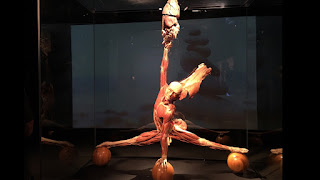Week 6: BioTech & Art
Blog #5: BioTech & Art
 |
| Astronauts at the ISS must be sanitized before launch. |
This week’s topic is probably the most controversial that we’ve seen so far. When we look at some of the art projects from this week’s lecture series, I think a strong reaction is probably elicited in all of us. Therefore, the first artist I’d like to discuss is Joe Davis. I think he’s a great example of both the good and the bad that can come of mixing biotechnology and art. On one hand, he represents a very creative and mercurial mixing of the “two cultures” that CP Snow analyzed. But he also represents the dangers of this mix: sending bacteria into space is a terrible idea. NASA, and every other spacefaring organization, takes great care to rid all bacteria from anything launched into space so as to not either harm any aliens out there or allow domestic bacteria to evolve unchecked in the cosmos. Davis disregards all of this in a careless manner with his E Coli project.
 |
| Marta de Menezes' butterflies with visible holes in their wings. |
I side more with Kathy High on this issue, who viewed lab rats as important creatures worthy of care — rather than lowly experimental objects. I also admire Stelarc, who implanted an ear on his left arm. If you’re going to alter an organism in the name of art, do it to yourself, not to the voiceless and innocent.
 |
| George Gessert's notes on an iris hybrid. |
Works Cited
“Bioart through Evolution: George Gessert.” Revolution Bioengineering, revolutionbio.co/bioart/bioart-through-evolution-george-gessert/.
“GFP BUNNY.” NATURAL HISTORY OF THE ENIGMA, www.ekac.org/gfpbunny.html#gfpbunnyanchor.
McCafferty, Georgie. “The Man With the Ear on His Arm.” CNN, Cable News Network, 13 Aug. 2015, www.cnn.com/style/article/stelarc-ear-arm-art/index.html.
Muller, Alber. “Tips for Beginners: Mechanics of Basic Hybridizing.” The American Rhododendron Society, 1996, www.rhododendron.org/v50n1p36.htm.
Senthilingam, Meera. “We're Growing Bacteria in Space, and They Could Help Us Create New Vaccines.” CNN, Cable News Network, 7 Oct. 2014, www.cnn.com/2014/10/01/health/super-bacteria-growing-in-space/index.html.
Stracey, Frances. “Bio-Art: The Ethics Behind the Aesthetics.” Nature News, Nature Publishing Group, 20 May 2009, www.nature.com/articles/nrm2699/figures/2.
Vesna, Victoria. "Biotech Lecture." . UConlineprogram. Web. 3 Nov 2013.
<https://www.youtube.com/watch?v=MdSt-Hjyi2I&list=PL9DBF43664EAC8BC7>.”


Tyler, I totally agree with your sentiments regarding the good and bad behind the mixing of biotechnology and art. I also believe that if this culmination results the harming of species, especially those that cannot voice their opinions or desires. However, my question is, what if those certain species that are genetically modified are not mutilated. Take for example, Alba, the green fluorescent bunny Eduardo Kac synthesized. What are your thoughts on this bunny, as technically only the color of the bunny was changed and it still had normal bodily functions.
ReplyDelete